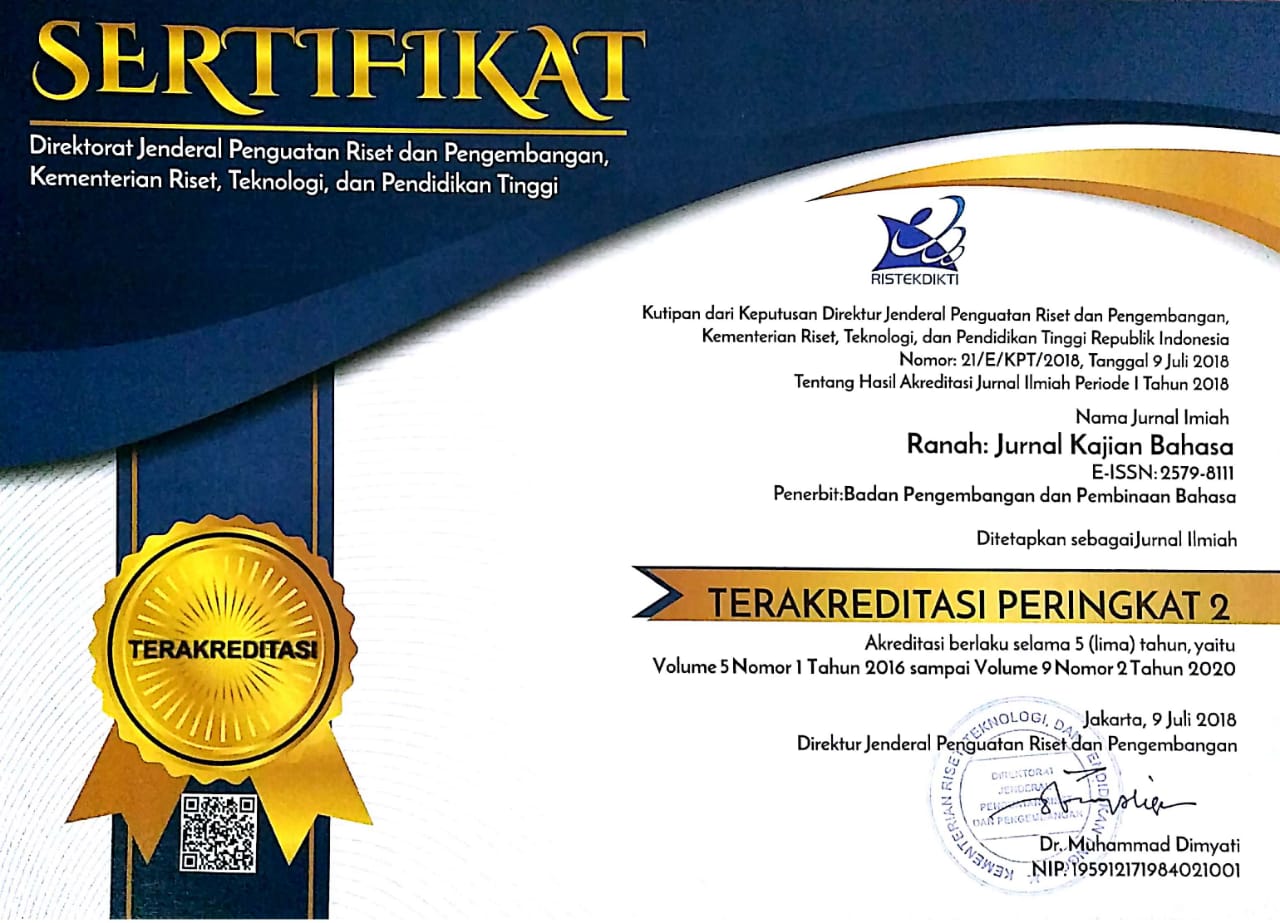Referential Choice in the Written Narratives of Indonesian Adults
Abstract
This study aims to describe the referential choice of two protagonist animate characters in a silent six-minute film entitled The Pear Story (Chafe, 1980). A total of 80 undergraduate and graduate Indonesian students were asked to watch the film and then retell the story by writing a narrative about the film in Indonesian. Findings indicate that when the protagonist animate referents are mentioned for the first time, a classifier seorang ‘a person’ is always used before the NP. When they are reactivated, they are mostly expressed by zero, pronouns dia or ia ‘he’, clitic –nya ‘his’ or ‘him’, NPs with determiners ini ‘this’, itu ‘that’, tersebut ‘aforementioned’, tadi ‘mentioned before’, NPs with relative clauses and NPs with definite articles si or sang ‘the’ which are often used in fables or tales. This study also demonstrates that the choice of anaphoric expressions of the protagonists is determined by factors such as referential distance and referential interference. This study confirms other cross-linguistic studies about referential choice – that there is a correlation between salience and referring expressions in discourse.
Abstrak
Penelitian ini bertujuan mendeskripsikan penggunaan acuan untuk dua tokoh utama dalam film bisu berdurasi enam menit yang berjudul The Pear Story (Chafe, 1980). Sebanyak 80 mahasiswa Indonesia tingkat Strata 1 dan Pascasarjana di sebuah universitas swasta diminta untuk menonton film tersebut dan kemudian menuliskan narasi mengenai film itu dalam bahasa Indonesia. Data menunjukkan bahwa jika referen kedua tokoh utama tersebut disebutkan untuk pertama kalinya, bentuk leksikal seorang selalu muncul sebelum frasa nomina (FN). Jika referennya diaktifkan kembali, maka yang digunakan adalah zero, pronomina dia atau ia, klitik –nya, FN + ini/itu/tersebut/tadi, FN + klausa relatif, dan si/sang + FN. Penelitian ini juga menunjukkan bahwa pilihan bentuk anaforik untuk kedua tokoh utama itu ditentukan oleh faktor jarak antara referen dan anteseden dan juga oleh adanya interferensi referen. Hasil penelitian ini sejalan dengan penelitian lintas bahasa mengenai pilihan acuan, yaitu bahwa ada korelasi antara referen utama dan bentuk acuannya.
Keywords
Full Text:
PDFReferences
Ariel, M. (1988). Referring and accessibility. Journal of Linguistics, 24(1): 65-87. https://doi.org/10.1017/S0022226700011567
Ariel, M. (1990). Accessing noun phrase antecedents. London: Routledge.
Casteele, A.V. (2013). A corpus-based study on referential chains in Spanish newspapers. Procedia - Social and Behavioral Sciences (95): 170-177. https://doi.org/10.1016/j.sbspro.2013.10.636
Chafe, W. (1980). The deployment of consciousness in the production of a narrative. In W. Chafe (Ed.), The Pear Stories: Cognitive, Cultural, and Linguistic Aspects of Narrative Production, 9-50. Norwood, NJ: Ablex.
Chafe, W. (1994). Discourse, Consciousness, and Time: The Flow and Displacement of Conscious Experience in Speaking and Writing. Chicago: The University of Chicago Press.
Dahl, Ö. & Fraurud, K. (1996). Animacy in grammar and discourse. In J.K.G.T Fretheim (Ed.). Reference and referent accessibility. Amsterdam: John Benjamins, 47-64. https://doi.org/10.1075/pbns.38.04dah
Fossard, M; Achim, A.M.; Rousier-Vercruyssen, L.; Gonzalez, S.; Bureau, A.; Champagne-Lavau, M. (2018). Referential choices in a collaborative storytelling task: Discourse stages and referential complexity matter. Frontiers in Psychology, 9, Article 179: 1-18. https://doi.org/10.3389/fpsyg.2018.00176
Fukumura, K. & van Gompel, R.P.G. (2010). The effect of animacy on the choice of referring expression. Language and Cognitive Processes. First published on 13 October 2010. https://doi.org/10.1080/01690965.2010.506444
Givón, T. (1983). Topic continuity in discourse: A quantitative cross-language study. Amsterdam: John Benjamins. https://doi.org/10.1075/tsl.3
Grüning, A. & Kibrik, A.A. (2005). Modeling referential choice in discourse: A cognitive calculative approach and a neural network approach. In Anaphora Processing: Linguistic, Cognitive and Computational Modelling. John Benjamins, 163-198. https://doi.org/10.1075/cilt.263.11gru
Guerriero, A.M.S.; Oshima-Takane, Y. & Kuriyama, Y. (2006). The development of referential choice in English and Japanese: A discourse-pragmatic perspective. Journal of Child Language, 33(4): 823-857. https://doi.org/10.1017/S030500090600763X
Gundel, J.; Hedberg, N. & Zacharski, R. (1993). Cognitive status and the form of referring expressions in discourse. Language 69, 274-307. https://doi.org/10.2307/416535
Gundel, J. (2003). Information Structure and Referential Givenness/Newness: How Much Belongs in the Grammar? In S. Müller (Ed.), Proceedings of the 10th International Conference on Head-Driven Phrase Structure Grammar, Michigan State University, 122-142. Stanford, CA: CSLI Publications.
Hedberg, N.; Gundel, J.; & Borthen, K. (2019). On different senses of 'referential'. The Oxford Handbook of Reference, J.K. Gundel & A. Barbara (Eds,) Oxford University Press, 1-18. https://doi.org/10.1093/oxfordhb/9780199687305.013.6
Huang, C. (2011). Referential choice in Mandarin child language: A discourse-pragmatic perspective. Journal of Pragmatics, 43(7): 2057-2080. https://doi.org/10.1016/j.pragma.2010.12.007
Huang, Y. (2000). Discourse anaphora: Four theoretical models. Journal of Pragmatics, 32(2): 151-176. https://doi.org/10.1016/S0378-2166(99)00041-7
Kibrik, A.A. (2011). Referential choice in Russian narrative prose. In A.A. Kibrik (Ed.). Reference in Discourse. Oxford: Oxford Scholarship Online. https://doi.org/10.1093/acprof:oso/9780199215805.001.0001
Kibrik, A.A.; Khudyakova, M.V.; Dobrov, G.B.; Linnik, A.; & Zaimanov, D.A. (2016). Referential choice: Predictability and its limits. Frontiers in Psychology, 7, Article 1429: 1-21. https://doi.org/10.3389/fpsyg.2016.01429
Orita, N.; Vornov, E.; Feldman, N.H.; & Daumé III , H. (2015). Why discourse affects speakers' choice of referring expressions. Proceedings of the 53rd Annual Meeting of the Association for Computational Linguistics and the 7th International Joint Conference on Natural Language Processing, pp. 1639-1649, Beijing, China, July 26-31, Association for Computational Linguistics. https://doi.org/10.3115/v1/P15-1158
Vogels, J. (2014). Referential choice in language production: The role of accessibility. Ph.D. thesis, Tilburg University. Tilburg Center for Cognition and Communication (TiCC).
DOI: https://doi.org/10.26499/rnh.v9i2.2930
Refbacks
- There are currently no refbacks.








